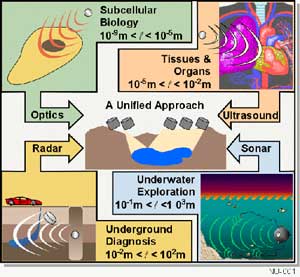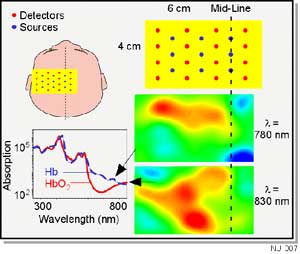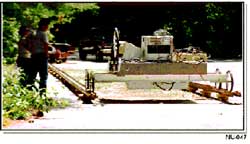
Center for Subsurface Sensing and Imaging Systems
Northeastern University (lead institution)
![]()
Looking into hidden worlds: Similar solutions for diverse problems
| A National Science Foundation Engineering Research Center since 2000 |
![]()
|
Partner Institutions:
Strategic Affiliates:
|
The Center for Subsurface Sensing and Imaging Systems (CenSSIS) seeks to revolutionize our ability to detect and image biomedical and environmental-civil objects or conditions that are underground, underwater, or embedded within cells or inside the human body. Our unified, multidisciplinary approach combines expertise in wave physics, sensor engineering, image processing, and inverse scattering with rigorous performance testing to create new sensing system prototypes that are transitioned to our industry partners for further development. An important outcome of this process is the education of students well-trained in these crucial fields for the future of public health and the preservation of the planet's physical resources.
 |
| The CenSSIS mission of "diverse problems, similar solutions" will enable advances in one subsurface domain to be applied in other domains. |
Some of the most difficult and intractable problems in sensing and imaging involve detecting, locating, and identifying objects that are obscured beneath a covering medium. Mapping pollution plumes underground, detecting a tumor inside the body, and identifying developmental defects in the interior of a multicelled embryo all share the problem of distinguishing the effect of a dispersive, diffusive, and absorptive medium from the desired details of the subsurface structure and functionality. The problem is similar whether the wave probe is electromagnetic or acoustic, whether the medium is soil or tissue, or whether the target is a land mine or a tumor. To address the research barriers that are common to advanced biomedical and environmental-civil applications of subsurface sensing and imaging, CenSSIS combines the strengths of four core universities and four affiliated hospitals and research institutions.
The combined 5-year investment by NSF and the four CENSSIS partner institutions is anticipated to be in excess of $28 million. In addition, substantial industrial support is anticipated to augment this core support.
Research
Research thrusts have been created in the following interrelated areas:
Thrust 1: Subsurface Sensing and Modeling
Creating fundamental knowledge of the interaction of nonlinear waves and dual-wave probes with subsurface media and targets, and fast forward-models for realtime inversion
Thrust 2: Physics-Based Signal Processing and Image Understanding
Developing inverse scattering algorithms to reconstruct objects in random inhomogeneous or cluttered media, recognition strategies for obscured and limited-view subsurface applications, and methods for combining different sensor inputs to optimize the information gained.
Thrust 3: Image and Data Information Management
Developing techniques for rapid processing, cataloging, storage, and retrieval of large image databases.
 |
| Blood oxygen level in an infant brain is imaged by optical diffusive wave spectroscopic analysis of data from an array of optical sources and detectors placed outside the skull. CenSSIS is advancing our ability to infer hidden structural or functional attributes from diffused, scattered, or distorted signals measured at the surface. |
Four testbeds integrate multiple sensing mechanisms with advanced common metadata standards to allow testing of inversion algorithms and imaging strategies against diverse experimental challenges in well-characterized model environments. These are BioBED (biological microscopies), MedBED (medical imaging in tissue), SoilBED (underground imaging), and SeaBED (underwater imaging). Sensors can be reconfigured in response to processing or recognition goals to achieve "end-to-end" optimization. Each testbed is network-linked so they can also serve as an educational resource, allowing students to test their skills in locating concealed objects in a variety of subsurface environments.
Some of the research topics being addressed by CenSSIS include: Humanitarian De-Mining, Multilayer Hyperspectral Oceanography, 3D Subretinal Visualization, Nonlinear Ultrasound Medical Imaging, Subcellular Biological Imaging, Electrical Impedance Tomography, Acoustic Diffraction Tomography, and Multi-Sensor Civil Infrastructure Assessment.
Our long-range vision is the development of a unified framework embodied in a set of computational, database, and visualization tools that we call "Solutionware." The combination of Solutionware and the experimental capabilities of the BEDs comprise the Grand Challenge Engineered System, I-PLUS. I-PLUS will apply our validated tools, knowledge, and experience to help solve important societal subsurface problems. I-PLUS will be tested with real-world applications that we will address in concert with our industrial and government partners.
Education
Our education program is based on 1) the vision of societal benefits emanating from a unified vision of a new discipline and 2) an engineered system approach. Features include:
- An undergraduate concentration in Subsurface Sensing and Imaging (SSI) at each academic partner.
- Interdisciplinary, team-taught graduate and undergraduate courses on SSI topics with access to web-controllable testbeds
- A "High-Tech Tools and Toys Laboratory" to introduce undergraduates to interfacing computers with state-of-the-art SSI systems and subsystems
- Undergraduate academic-year research experiences funded by industry and tied to co-op placements or summer internships at participating companies
- Regular programs of student and faculty exchanges, including visiting positions for scientists from our affiliated institutions.
Pathways are also being created to engage the interest of K-12 teachers and students in SSI.
Industrial Collaboration and Technology Transfer
The goals of our industrial collaboration/technology transfer program are: (1) to increase corporate financial support of fundamental research in subsurface sensing and imaging; (2) to transfer technologies through intellectual property policies that fairly and openly distribute revolutionary advances developed in the ERC, respect corporate proprietary interests, and protect the rights of Academic Partners and Strategic Affiliates; and (3) to greatly increase the number of undergraduate and graduate students whose cooperative education employment, industrial internships, and graduate fellowships connect education and research in the academy with industrial work to facilitate technology transfer.
 |
| The NU outdoor underground test track (a component of SoilBED) collects Ground Penetrating Radar data for algorithm validation on a project leading to more effective humanitarian de-mining technologies. |
The Industrial Partners of CenSSIS span the medical, biological, environmental, security, and defense applications of SSI technology. Industries can partner with CenSSIS in modes that fit their corporate culture. Large companies have the resources and flexibility to fund basic work with product line impact in the 2- to 5-year range. Smaller companies, focusing on nearer horizons, advance projects by modifying existing market systems to incorporate algorithmic advances or optimized sensor configurations.
Partnership levels are awarded based on points awarded to each investment component. Increasing privileges at each level encourage partners to participate substantially in the ERC. Benefits include indirect cost reductions for proprietary research, licensing fee reductions for technologies and software developed through the ERC, and scaled tuition for training programs and courses developed specifically for the ERC. Technology transfer is fostered by the breakthoughs created via a core research investment exceeding $5 million per year. An additional means of technology transfer is the extensive student exchange through the ERC between industry and university. Undergraduate and graduate internships and co-op placements on corporate sites linked subsequently to research projects guided by industrial and faculty mentors on the ERC campuses effectively transfer technologies among the ERC, its industrial partners, and various markets.
Facilities
CenSSIS includes 52,400 sq. ft. of total space distributed across the four academic partners and strategic affiliate sites, including 46,400 sq. ft. of existing, and 6000 sq. ft. of new or renovated, laboratory space. The extensive facilities and specialized expertise of our strategic partners—LLNL, MGH, BWH, and WHOI—expand our capabilities in the biomedical and environmental/civil infrastructure fields.
Center Organization and Leadership
Prof. Michael Silevitch, Director of CenSSIS, has full management responsibility, including budgeting funds, resource allocation, and risk identification and mitigation. Prof. Silevitch has been Director of the NSF-sponsored Center for Electromagnetics Research (CER) at NU since 1983. Under his direction, the CER completed over 100 government and industrial projects with a $21M budget. As a leader in K-12 education reform, Prof. Silevitch has 7 years experience in the leadership and management of large statewide, multi-institution, multi-task, high-stakes initiatives similar to that of the ERC.
Prof. Bahaa Saleh is the CenSSIS Deputy Director. He is the Chair of the Department of Electrical Engineering at BU and is internationally recognized for his research contributions in the areas of photonic sensors and physics-based image processing - key disciplines of our ERC.
CenSSIS management includes both direct institutional representation and cross-institutional teams (for the three research thrusts and the education component). Each institution is represented by an Associate Director.
![]()
Center Headquarters
Center for Subsurface Sensing and Imaging Systems ERC
Northeastern University
360 Huntington Avenue, Room 235FR
Boston, MA 02115
Tel (617) 3735110 · Fax (617) 3738627
Homepage: http://www.censsis.neu.edu
Center Director: Prof. Michael B. Silevitch, Ph.D.
(617) 3735110· msilevit@lynx.neu.edu
Deputy Director: Prof. Bahaa E.A.Saleh, Ph.D.
(617) 3537176 · besaleh@bu.edu
Director, Finance & Operations: Ms. Jacquelyn L. Wheeler
(617) 373-5111 · jwheeler@lynx.neu.edu
Industrial Liaison Director: Mr. Christopher J. Cassidy
(617) 373-2976 · ccassidy@coe.neu.edu
NSF 00137s